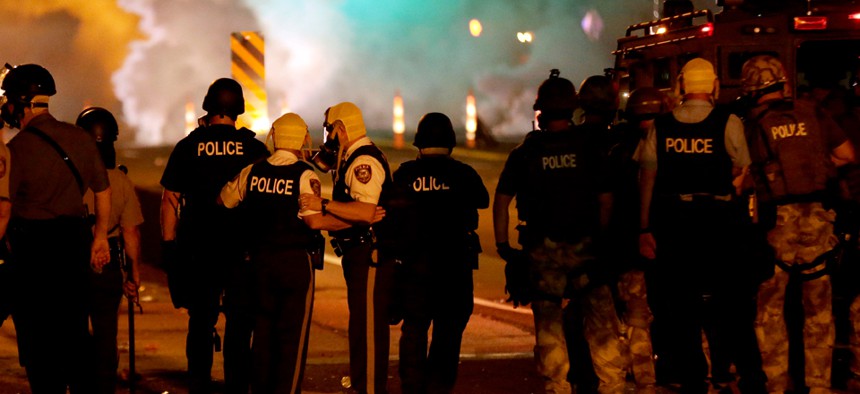
Police talk after deploying tear gas Sunday evening in Ferguson, Missouri. Charlie Riedel/AP
Why the National Guard Is Coming to Ferguson
A look at the soldiers being called in to keep the peace.
Missouri Gov. Jay Nixon announced he will send elements of his state's National Guard to Ferguson early Monday morning, a response to increasingly restive demonstrations that grew out of last week's police shooting of 18-year-old Michael Brown.
The National Guard's involvement indicates a further escalation of security needs in Ferguson since Nixon replaced local police on the scene with state police from the Missouri Highway Patrol last week.
A look at the history of the National Guard and its recent domestic deployments gives a sense of the gravity of the situation in Ferguson.
The women and men of the National Guard are called upon to respond to myriad needs, both domestic and foreign. Members of the Ohio National Guard were tasked with controlling an anti-Vietnam War protest at Kent State University in 1970, and the California National Guard was called up to respond to the 1992 Rodney King riots in Los Angeles. In 2005, more than 30,000 members of the National Guard took on a disaster-relief role after Hurricane Katrina devastated coastal Louisiana and Mississippi. And earlier this month, Texas Gov. Rick Perrycalled up 1,000 soldiers from the Texas National Guard to beef up security at the border. Guardsmen and -women are also called into active duty overseas in times of war, and many were deployed to fight in Iraq and Afghanistan.
Domestically, the National Guard's record isn't sterling. In its response to demonstrations at Kent State University and the Rodney King riots in Los Angeles, the National Guard shot and killed protesters. Its tactics in these situations were decidedly military: In Los Angeles, Guard members, dressed in combat fatigues and carrying automatic rifles, helped enforce a citywide curfew, returning quiet to the streets within a week of their arrival. At Kent State, the Guard deployed tear gas, and the presence of the armed soldiers gave the campus the appearance of a "military war zone," according to two of the university's professors. Many of the soldiers on campus were holding rifles outfitted with bayonets.
And in the aftermath of Hurricane Katrina, the National Guard's response was hobbled by problems in coordination and communication and a lack of "situational awareness," according to its own review of the action.
The National Guard serves in a unique dual role as a state and federal force. In Missouri, Gov. Nixon mobilized his own state's National Guard, compelling it to act in its capacity as a state militia. The federal government can also take control of the National Guard from state authorities: In 1957, for example, President Eisenhower wrested command of the Arkansas National Guard from then-Gov. Orval Faubus, who had deployed the troops to block black students from attending the previously whites-only Little Rock Central High School. The federalized National Guard then protected students as they began to integrate the school.
Members of the National Guard are part-time soldiers. After entering the force, they generally train one weekend a month while holding civilian jobs or attending college.
In a development representative of the spotty communication between local, state, and federal authorities that has characterized the last two weeks in Ferguson, the White House said it was unaware that the governor was sending the National Guard in. "Folks didn't know," an administration official told BuzzFeed Monday.
The National Guard's involvement in Missouri demonstrates how much the situation in Ferguson has gotten out of hand. In a crisis where police brutality is at the center of attention, combat-trained National Guard soldiers will be under intense scrutiny as they come in as a police force, attempting to deescalate an increasingly tense situation.







